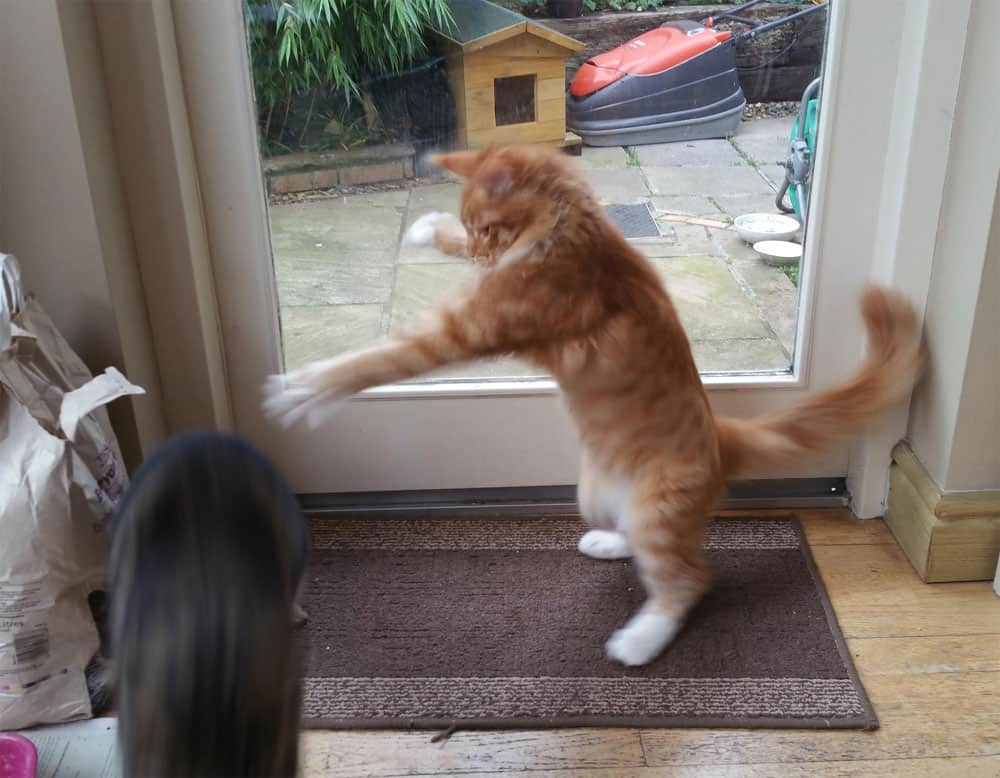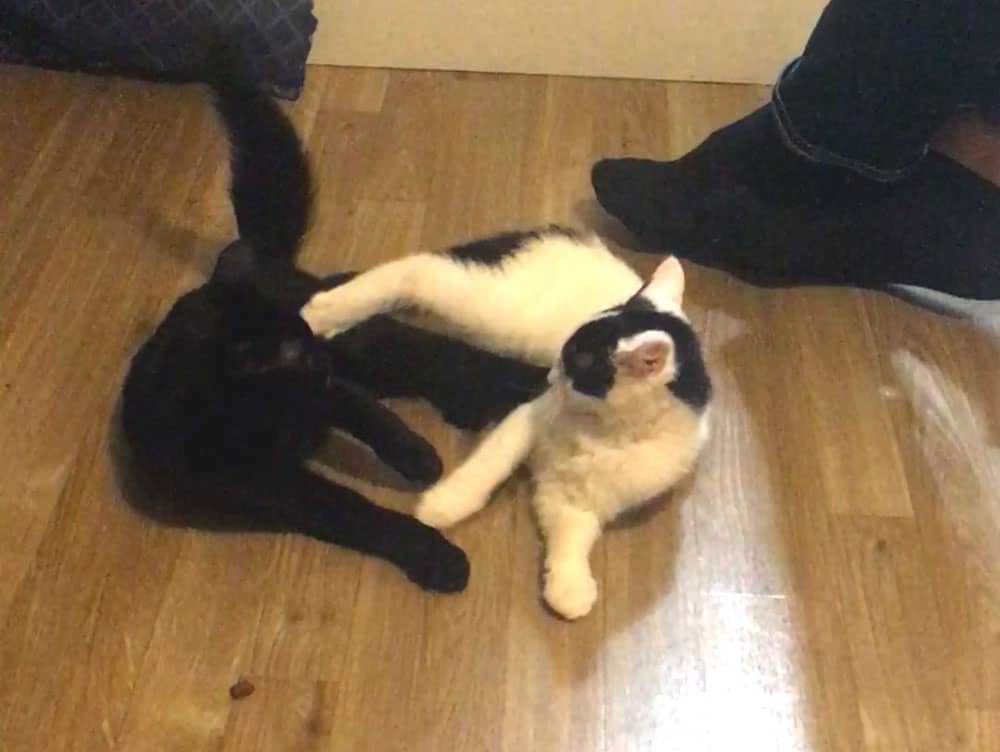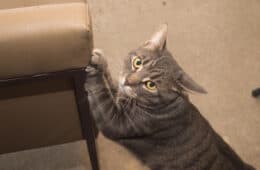It’s common to see cats roughhousing, but that often leaves cat owners wondering: Are my cats fighting or playing? After all, if they’re playing, you want to encourage them. But if they’re fighting, you may need to intervene!
In short, when cats fight, they have their ears pinned all the way back, the whites of their eyes are showing, and they will be extremely vocal.
Cats that are playing will usually have their ears forward or slightly sideways, normally-dilated pupils, and they’ll be mostly quiet.
There’s a lot more to cat body language than that, however, and it can be difficult to tell the difference between cats that are simply playing rough with each other or actually fighting. Keep reading and we’ll break down each of these behaviors for you and provide visual examples.
By the end of this post, you should be able to quickly tell the difference between a catfight and a cat play fight.
Spotting the Signs of a Serious Cat Fight
First, let’s take a look at what a fighting cat will look like. We’re going to go over each part of the body individually but keep in mind that it’s all of them put together that let you know a cat is fighting. If your cat only displays one or two of these, they may be playing or simply annoyed.
Listening to the Ears
In a fighting cat, the ears will be pinned all the way back. If you can see your cat from the front, you probably can't even see his ears because of how tightly they’re pinned to his head. Typically, the ears won’t move, either, even in response to sound.
Eyes on the Eyes
The next thing you want to look at is the eyes. In a cat that’s preparing to or already in a fight, the pupils will be extremely dilated. You will also be able to see the whites of her eyes. She will also have them laser-focused on what she’s fighting with, and it will be nearly impossible to distract her.
Understanding the Tail Language
A cat’s tail can tell you a lot about what he’s thinking and feeling. Before a fight, a cat’s tail will get bushy as he tries to make himself look bigger. In the excitement of a fight, it will usually stay that way, with all the hair standing on end.
The movement of his tail is also a factor in determining whether he’s playing or fighting. When cats are angry or extremely annoyed, their tails lash rapidly, with the whole length of the tail moving. This is a warning that an attack is imminent.
Keeping an Eye on Claws
There’s a phrase about the “claws coming out” when humans interact and get mean or aggressive toward each other. That comes from cats fighting. When cats are legitimately fighting, their claws are out. It can be hard to see from a distance, but when fur from the other cat is flying, it’s likely being pulled out by the other cat’s bared claws.
Reading the Posture
When two cats are facing off to fight, they usually stand sideways rather than facing each other head-on. This is an attempt to make themselves appear larger. In the midst of a fight, this could change, but the important thing to look for is how tense they are.
In a fight, a cat will be tense the whole time. She won’t sit completely on her rear end, though she may crouch low to the ground. If she lies down, it may be to get into a better fighting position.
Although exposing the stomach may be seen as a submissive move, from this angle, another cat has to get through all four clawed paws and a mouthful of teeth to get to any vital parts.
Paying Attention to Vocalizations
Cat fights are LOUD. There’s no mistaking the screams, yowls, cries, and more a cat may let out before and during a fight. In fact, most catfights involve far more vocalizations than actual physical interactions. This is because most cats don’t want to actually fight.
As you’ll see, the last two points have to do with the context of the interaction your cats are having. This is also important in determining whether your cats are fighting or playing.
Understanding The Dynamics Of Cat Relationships
Cats that don’t know each other are far more likely to fight than old friends, which is why you have to consider how well your cats know each other.
If you’re introducing two adult cats to each other who have never met before, there’s a good chance the interaction you’re seeing is a fight.
This is why it’s important to introduce cats properly to each other at any age. Otherwise, the resident cat will feel as though their territory is being threatened and will act accordingly. Most often, this means fighting with the intruder.
Read more:
How To Successfully Introduce Cats: The Ultimate Guide
Taking Relationship and Situation Into Account
If your older cat was eating her special soft cat food and your younger cat tried to steal it, this is a situation in which an otherwise calm cat may choose to fight with another one.
Or, if your cat is in an unfamiliar situation that already has them nervous, they’re more prone to fight with other cats.
With all of these things in mind, let’s take a look at this video of a catfight. It’s a real video of real cats fighting and is intense, so be prepared.
As you’ll see, they do a lot of screaming at each other and some actual fighting. Notice in particular the way their bodies are completely tense the entire time. Every muscle is ready for that fight. You can also see the fur flying when they collide.
Warning: Your cats may be upset by the soundtrack. If they're around, switch to headphones before playing this video.
Signs Your Cats Are Playing
Now that you’ve gained a better understanding of what a fighting cat looks like, let’s look at what a playing cat looks like. As you’ll see, there are many overlaps between the two, but there are also distinct differences. As with a fighting cat, it’s a combination of these that indicate when a cat is playing.
SIGN UP FOR THECATSITE'S EMAIL UPDATES >
Tuning Into the Ears
While cats do pin their ears while playing, it’s rare for them to pin them all the way down on their head. Most of the time, a playing cat’s ears will be forward, facing her friend, or sideways in a fake earpin. She’ll also move her ears towards sounds and can be easily distracted by your voice.
Noting the Eyes
Cats’ pupils get bigger while they’re playing, but not quite as big as when they’re fighting. This is simply because they’re excited. However, in most cases, you shouldn’t see the whites of their eyes when cats are playing.
They may also look around during the interaction and won’t keep their eyes focused so intensely on the other cat when playing. This is because they know they’re not in danger, so if there’s something interesting to look at, they’ll look at it.
Reading the Tail
An excited cat may puff up his tail even when playing. This is especially common when play-fighting. It may even make some twitch-like motions. However, it will be up in the air while playing, body language that announces they’re feeling friendly.
Checking the Claws
Two cats that are playing don’t want to hurt each other. So, if they learned properly from their mothers as kittens, they’ll keep their claws in while playing. Again, this is hard to see for sure but is one of the ways you can tell if a cat is just playing or fighting.
Understanding the Posture
This is another one that can be tricky since cats that are play-fighting will take on aggressive stances. However, in play, these stances will change frequently. For example, a cat may run up to his friend “aggressively” and then turn and run away.
A cat will also relax in the midst of play. He will sit all the way down on the ground, or lie on his side with no intention of protecting himself. He may also pause to lick himself, which is a sure sign that he’s enjoying himself and not in a fight.
Listening to Vocalizations
Cat play is usually quiet as far as vocalizations go. The only sounds you should be hearing are the pounding of your cats’ feet as they chase each other around the house.
When a cat hisses or cries out in the midst of play, it usually means they’ve had enough, or that the other cat accidentally hurt her. Be sure to check in with your cats when you do hear a painful meow, and make sure the other cat has backed off to avoid it turning into a real fight.
Most of the time, cats that have grown up with their mothers and siblings learn early on how far they can take their rough play. And, they stop as soon as their playmate cries out in pain because they didn’t mean to hurt them.
Once again, these last two points are going to cover the overall context of the interaction.
Taking Relationship and Situation Into Account
It’s rare for cats that grew up together or have always had positive interactions with each other to suddenly start fighting. More than likely, if your cats are littermates or knew each other from kittenhood, they’re playing together.
Most often, it’s cats that don’t know each other well or at all that will fight with each other. Male cats tend to remain playful throughout their lives, so they’re more likely to continue to play fighting even after adolescence, whereas females usually mellow out after they reach maturity around age two.
If your cats were relaxing in the sunlight and then one started poking the other with his paws and now they’re engaged in an epic battle, chances are they’re just playing.
If there doesn’t seem to be any reason for your cats to be upset, then it’s more likely a play session has broken out rather than a fight.
Now, let’s take a look at this video of two cats play-fighting. As you can see, they’re both relaxed throughout the interaction. The long-haired tabby is even slow-blinking at his brother at one point, letting him know he’s enjoying their game.
Warning: Your cats may be upset by the soundtrack. If they're around, switch to headphones before playing this video.
What to Do if One Cat is Playing and the Other is Fighting?
In most situations, both cats will be either playing or fighting. However, sometimes you may run into situations where one cat is thoroughly enjoying himself and the other cat is ready to battle for real. There are a few things you can do if you find yourself in this situation.
Wait and See
There are two situations in which you will probably want to just wait and see what happens: when your cats are buddies, and when it’s an older cat with a kitten.
Cats that are good buddies annoy each other sometimes. However, if you’re confident that they’re not going to actually fight, then you can keep an eye on them and let them work it out themselves. Most often, once the playing cat realizes the other is upset, he’ll back off.
Kittens love playing to the point where they annoy older cats with their enthusiasm. However, older cats recognize that kittens will be kittens and will usually just discipline them.
This is a good thing, so don’t scold your older cat for giving a rambunctious kitten a solid thump every once and a while.
Distract A Playful Cat
Most of the time, the cat that’s playing simply has more energy than the other, and that’s the main problem. This is particularly true when a kitten or young cat is involved. To rescue the other cat from their annoying advances, engage her in play.
Sometimes, all she needs is something or someone else to play with. Then she can play to her heart’s content, and the other cat can get all the rest he wants. Both cats will thank you for stepping in and distracting the playful one.
Intervene—Without scaring the cats
In some cases, you may need to intervene. If you have a grouchy older cat that isn’t afraid to express himself with claws and a young cat that can’t take a hint, it might be best for you to jump in and save them both from the situation.
You may need to separate them for a little while to give the upset cat time to relax. It’s also a good idea to play with the other cat to help them burn off that extra energy. That way, when they’re reunited, they’re more evenly matched when it comes to energy levels.
How to Stop a Cat Fight
When you’re facing a legitimate catfight, there are some steps you need to take to prevent either cat from getting injured. The more quickly you intervene, the less likely there will be wounds to take care of.
At the same time, you don’t want to get yourself bitten or scratched. Cats in the midst of a fight see everything as the enemy and won’t hesitate to attack you with everything they have. Because cats’ teeth and claws contain a myriad of bacteria, these types of wounds can be dangerous.
Another consideration to keep in mind: You don't want the cats to become even more scared. If the fight is in the early stages and you intervene by scaring them, they'll end up associating the other cat with something scary. That's not good. It may trigger another fight the next time another cat is around.
That's why you should avoid making loud noises, shouting, or otherwise scaring the cats involved. Do not spray water on any of the cats either. Read more on why spraying cats with water is never a good idea.
Here are a couple of ways you can stop a catfight safely for everyone involved.
Block visual contact using a blanket or large towel
Glaring eye contact is a sign of aggression in cats. Fighting cats often spend a significant part of the fight simply staring right into one another's eyes and yowling.
Get a large towel or blanket and quietly place it between them to break that line of vision. The cats will look confused at first but should soon show signs of visible relaxation.
Try to direct one cat away by gently nudging him or her with the blanket away from the other cat. Aim at getting the cats into separate rooms to allow them time to relax.
If the cats are already entangled in a catfight, you can try and use a blanket to separate them. They can become tangled up in the blanket which pulls them apart from each other and can help confuse them.
A blanket can also help protect your hands if you still need to physically pull one cat off the other. Just keep in mind teeth and claws can still penetrate blankets!
Use a Broom to separate the cats
Whether it’s a broom, a mop, or even a stick if you’re outside, any sturdy object that keeps your body far away from the fighting cats can help you break up the battle. The goal with this is to get them to separate and latch onto the object instead of each other.
Be careful when doing this not to hit the cats with the broom, as you could end up injuring them yourself. Instead, just gently shove it between them. In some cases, cats that are afraid of brooms or mops will run at the sight of them coming at them.
What to do after you break up a catfight?
If you're absolutely sure your cats were really fighting - and not play-fighting - you're going to need to work on the issue.
Start by separating the cats and reading up on the possible reasons for feline aggression. Use these resources:
Next, turn to our guide about how to re-introduce cats:
How To Fix An Unsuccessful Cat Introduction
You have your work cut out for you, so be patient and work with these guides. Post in the cat behavior forum if you need more help, advice, and support from our members.
Examples of Cats Playing or Fighting from the Forum
Let’s take a look at some real-life examples of feline interactions from the forum to see what we can learn.
New Kitten with Older Cats
This first example comes from FaBEAR.
“My 5.5-month-old kitten Tiger is starting to annoy the older cats! He does it with the dog as well, but it's funnier with him. With the two older females - he will rise up on his back legs and bat at them with his front paws when they are just sitting there doing nothing!
They do not like him at all!!! I'm wondering if he is being aggressive/dominating or just playing. He is due to be neutered at 6 months old, but I wonder if it is because he is reaching sexual maturity?”

In this case, it’s pretty clear that Tiger is simply playing with the older cats, even if they’re not enjoying his games. He’s a young cat who has a lot of energy and wants to burn it off by interacting with his new sisters. And, he likely doesn’t realize they’re not enjoying it.
Because he’s also got a lot of hormones running through his system, those may be driving him to express dominance over the other cats in the house. Hopefully, this behavior will change once he gets neutered and he’ll just be playing normally.
In the meantime, his owner should be engaging him regularly in play to keep him busy and make sure the other cats have safe retreats so they can have their quiet time. This will help her maintain the peace while they all wait for him to settle down a bit.
Two New Kittens
This situation happened with Brittanydevv, who was understandably concerned about her kittens.
“I recently adopted 2 kittens. I got them 2 weeks apart, so I figured the ‘resident’ kitten wouldn't find it too hard to adjust to a new kitten because he's been here for such a short time. Anyway, I did the introduction process… But no matter what I do they just attack each other…
“When they fight there is growling and hissing sometimes so I'm sure they aren't playing. When they do fight relatively quietly, I let them keep going to see if they will get bored or just stop.
But it always gets to a point where it gets loud and very aggressive and I have to separate them. But when they are separate, they cry to get either in the isolation room or to get out.”

Although the sounds made her wonder if they were actually fighting, the truth is these two youngsters were just playing especially rough. This is a great example of why you need to look at the whole picture. One of the pictures she uploaded makes the situation clear.
It shows the two of them in the midst of a battle, lying on their sides facing each other. Their ears are to the sides, and they both look completely at ease. They’re obviously enjoying their time together, even if they end up hissing and growling in a few minutes.
There are two explanations for this situation. First of all, it could just be that they’re young boys that like to play rough, and being loud is part of their play. But, the more likely explanation is that they’re getting too rough and letting each other know by getting vocal.
In time, these two will learn to play nicer with each other.
Two Adult Cats
Here’s the last situation we’ll look at in this post, which was written by Ire17.
“Just wanted to check if this is playing or fighting (the orange one, Oscar, is usually on the bottom but he sometimes jumps on his brother and starts it, but mostly the black one, Felix, starts it). They are 4, littermates, fixed, and I adopted them as a bonded pair.
I am just trying to check all my boxes here since Oscar is having some out-of-the-litterbox trouble and I want to make sure it isn’t because they are fighting.”
What’s also important to note here is the context of their relationship. These two are littermates and have lived together for their entire lives. They spend time curled up together, clean each other, and are best buddies. It’s extremely rare for cats of this age with this type of relationship to fight.
Fighting or Playing Checklist
Here’s a quick list of questions you can ask yourself to determine if your cats are fighting or not.
- Are their ears pinned all the way back on their heads?
- Are they staring intently at each other and not looking away?
- Are their tails down, puffed-up, and twitching violently?
- Are their claws out? Do you see fur flying?
- Are their bodies tensed up throughout the interaction?
- Are they vocalizing loudly and constantly?
- Do they know each other previously or have a history of not getting along?
- Is one cat encroaching on the other’s territory?
If you’ve answered “yes” to most or all of these questions, there’s a good chance your cats are actually fighting, and you should intervene as quickly as possible to avoid an emergency trip to the vet.
If you mostly answered “no,” your cats are probably just playing, and you can keep an eye on them to make sure one cat isn’t feeling overwhelmed and in need of a break.
SIGN UP FOR THECATSITE'S EMAIL UPDATES >
Hopefully, this will help you determine whether your cats are playing or fighting so you can take appropriate action! If you’re still not sure, we recommend recording a video and posting your query in TheCatSite forums so our members can help you understand your cat’s behavior.
Note: We may get commissions for purchases made through links on this page.




4 comments on “Are My Cats Fighting Or Playing? [Answered]”